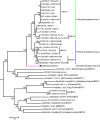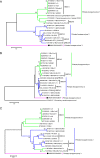Novel Primate Bocaparvovirus Species 3 Identified in Wild Macaca Mulatta in China
- PMID: 31552610
- PMCID: PMC7035407
- DOI: 10.1007/s12250-019-00163-8
Novel Primate Bocaparvovirus Species 3 Identified in Wild Macaca Mulatta in China
Abstract
Primate bocaparvovirus (BOV) is a possible cause of respiratory disorders and gastroenteritis in humans. However, the diversity and evolution of these viruses remain largely unknown, despite the identification of a growing number of BOVs in non-human primates (NHPs). Here, we report the identification of a novel BOV (provisionally named Macaca mulatta bocaparvovirus [MmBOV]) in the feces of wild Macaca mulatta in China by viral metagenomic analysis. Seven of 400 fecal samples from Macaca mulatta were positive for MmBOV. An almost complete genome sequence of 4,831 nucleotides was obtained, which had genomic organization and protein motifs similar to human bocaviruses (HOBVs), and shared characteristically low G/C content and weak codon usage bias. Sequence analyses of NS1, NP1, and VP1 revealed that MmBOV was most closely related to HBOV4 of Primate bocaparvovirus 2 (approximately 68.4%/70.6%, 73.3%/67.6%, and 70.4%/73.1% nucleotide/amino acid identities, respectively). Additionally, phylogenetic analysis revealed that MmBOV formed an independent peripheral branch, but clustered closely with those of the Primate bocaparvovirus species in the BOV genus (particularly HBOV4). These data strongly suggest that HBOV4 originated from NHP bocaparvoviruses around 200-300 years ago, and that NHPs may act as HBOV reservoirs. Following the International Committee of Taxonomy for Viruses guidelines, we propose MmBOV as a new species (tentatively named Primate bocaparvovirus 3) in the genus Bocaparvovirus, which is the first report of a novel species of primate BOV. Our data facilitate future research on the genetic diversity and evolution of primate bocaparvoviruses and highlight the importance of bocaparvovirus surveys in wild NHPs.
Keywords: Macaca mulatta; Novel species; Phylogenetic analysis; Primate bocaparvovirus (BOV); Sequence analysis.
Conflict of interest statement
The authors declare that they have no conflict of interest.
Figures




Similar articles
-
Two novel bocaparvovirus species identified in wild Himalayan marmots.Sci China Life Sci. 2017 Dec;60(12):1348-1356. doi: 10.1007/s11427-017-9231-4. Epub 2017 Dec 5. Sci China Life Sci. 2017. PMID: 29218438 Free PMC article.
-
Identification and characterization of a novel rodent bocavirus from different rodent species in China.Emerg Microbes Infect. 2018 Mar 29;7(1):48. doi: 10.1038/s41426-018-0052-y. Emerg Microbes Infect. 2018. PMID: 29593218 Free PMC article.
-
Identification of a novel bocaparvovirus in a wild squirrel in Kunming, Yunnan Province, China.Arch Virol. 2020 Jun;165(6):1469-1474. doi: 10.1007/s00705-020-04613-7. Epub 2020 May 9. Arch Virol. 2020. PMID: 32388598
-
Human bocavirus: Current knowledge and future challenges.World J Gastroenterol. 2016 Oct 21;22(39):8684-8697. doi: 10.3748/wjg.v22.i39.8684. World J Gastroenterol. 2016. PMID: 27818586 Free PMC article. Review.
-
Porcine bocavirus: achievements in the past five years.Viruses. 2014 Dec 10;6(12):4946-60. doi: 10.3390/v6124946. Viruses. 2014. PMID: 25514206 Free PMC article. Review.
Cited by
-
Occurrence of Typical Domestic Animal Viruses in Wild Carnivorans: An Emerging Threat to the Conservation of Endangered Species.Transbound Emerg Dis. 2024 Feb 7;2024:3931047. doi: 10.1155/2024/3931047. eCollection 2024. Transbound Emerg Dis. 2024. PMID: 40303121 Free PMC article.
-
Zoonotic pathogens in wild Asian primates: a systematic review highlighting research gaps.Front Vet Sci. 2024 Jun 27;11:1386180. doi: 10.3389/fvets.2024.1386180. eCollection 2024. Front Vet Sci. 2024. PMID: 38993279 Free PMC article.
-
Small but mighty: old and new parvoviruses of veterinary significance.Virol J. 2021 Oct 24;18(1):210. doi: 10.1186/s12985-021-01677-y. Virol J. 2021. PMID: 34689822 Free PMC article. Review.
-
Current Insights into Porcine Bocavirus (PBoV) and Its Impact on the Economy and Public Health.Vet Sci. 2024 Dec 22;11(12):677. doi: 10.3390/vetsci11120677. Vet Sci. 2024. PMID: 39729017 Free PMC article. Review.
References
MeSH terms
Substances
LinkOut - more resources
Full Text Sources
Miscellaneous

